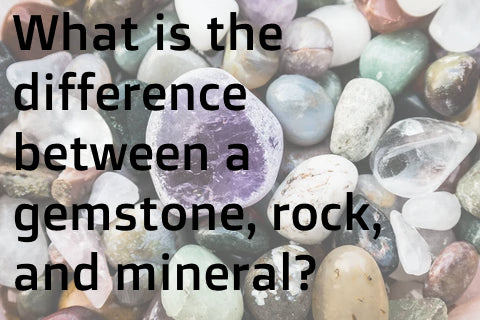MOTHER'S DAY SALE! Up To 50% OFF & 15% OFF Code: MOM15 + Free Shipping |Track My Order
What is the Difference Between a Gemstone, Rock, and Mineral?

Gemstones, rocks, and minerals are extremely important to the jewelry industry. At our jewelry store, we believe in providing not just beautiful pieces but also empowering our customers with knowledge. Understanding the distinctions between gemstones, rocks, and minerals is crucial in appreciating the world of jewelry and gemology. Let's delve into what sets each category apart:
Gemstones
A gemstone is usually a mineral, but it is one that has formed crystals and then been cut and polished professionally to be made into a piece of jewelry. They come in an array of colors. The study of gemstones is called gemology. This is a type of mineralogy (the study of minerals) that is the study of the physical properties seen by the naked eye and also in magnification of the stone. The evaluation of a gemstone is based on the value of the gem given by a gemologist, one who studies these gems. It is usually a decorative and very beautiful stone, and it is also usually very valuable as well.
Gemstones are usually measured by their hardness, size, and rarity. Unpolished, loose gemstones simply look like ordinary rocks; cutting and polishing allows them to have brilliance and sometimes color (leading to their value) that can't be found in other types of stones. Gemstones are usually classified as semiprecious and precious stones. Some semiprecious gemstones include amethyst, garnet, citrine, turquoise, and opal. Precious gemstones include diamond, emerald, ruby, and sapphire. Gemstones are often used as focal points in jewelry, adding elegance and value to pieces. A full range of colors are available. Pink, blue, orange, red, purple and green hues are used in jewelry.
Rocks
The scientific term for rocks is petrology, and understanding them is crucial for understanding the formation and mineral makeup of the earth. Rocks are made from minerals and can come in every size: They can be tiny pebbles or mountains big enough on which to climb or drive. Rocks do not have a special chemical or mineral makeup. While most rocks are not cut or polished to be used as gemstones, some rocks, including lapis lazuli, are classified as gems. Examples include granite, marble, limestone, and obsidian.
Minerals
Minerals occur naturally within the earth's surface and are solid formations. They are defined by their shape and their crystalline makeup. They are formed when magma, which is molten rock, cools. They can also be formed by water in caverns under the sea. Minerals are usually found between sediments or in areas that contain lava flows. There are more than 4,000 minerals that are formed naturally within the earth, and each one has a specific crystal structure.
Minerals belong to one of 15 different chemical groups, and these represent the compounds they contain. Minerals have different distinct classifications. Some of these are color, luster, tenacity, hardness, and fracture. Some minerals can have properties such as radioactivity or fluorescence as well. Many minerals are on the periodic table of elements as composed of a single element like silver or tungsten, but every mineral is made of some combination of these elements.
Minerals are mined for several different reasons. There may be a distinct need for the different elements that they may contain, but some are mined simply for their appearance. New types of minerals are constantly being discovered within the earth's surface.
So minerals are crystals that make up different types of rocks and gemstones. Gemstones are usually minerals (but sometimes rocks) to which we give more value and that jewelers can make into something attractive. And rocks are made up of all kinds of minerals, and there are thousands and thousands of different types of minerals. Of course, there are slang terms as well, but understanding the differences between rocks, minerals and gemstones can save you from purchasing the wrong inlay for your very important ring.
Key Differences:
-
Composition: Gemstones are specific types of minerals valued for their beauty, while rocks are composed of one or more minerals. Minerals are the individual chemical compounds that make up both gemstones and rocks.
-
Use in Jewelry: Gemstones are directly used in jewelry making due to their aesthetic appeal and durability. Rocks serve as sources for gemstones or decorative elements but are not typically used directly in jewelry.
-
Formation: Gemstones often form under specific geological conditions over long periods, while rocks can form through various geological processes such as cooling and solidification or through pressure and heat. Minerals are the fundamental components of both gemstones and rocks, forming through crystallization from molten rock or precipitation from solutions.
Understanding these differences can deepen your appreciation for the beauty and complexity of the natural world and the jewelry crafted from its treasures. Whether you're seeking a stunning gemstone ring, a unique rock specimen, or a mineral-inspired piece of jewelry, our store offers a diverse selection to cater to your preferences and interests. Explore our collection and discover the perfect piece to adorn yourself or gift to a loved one.




